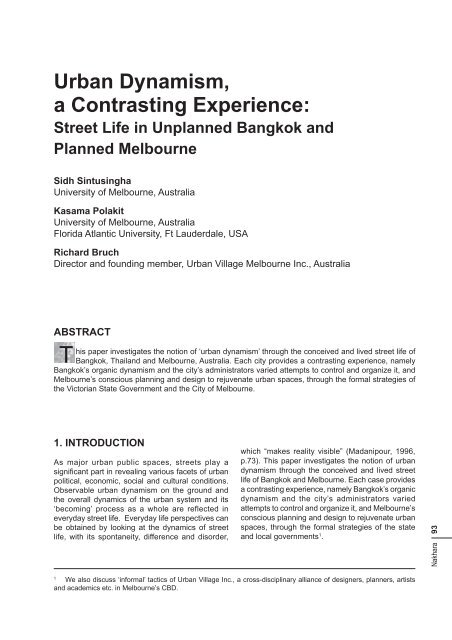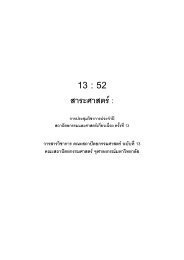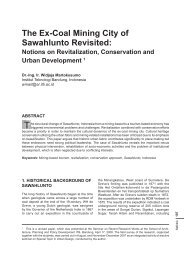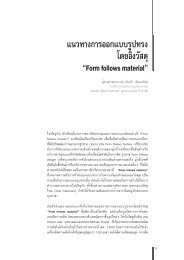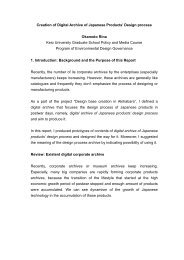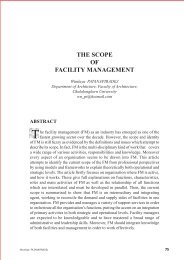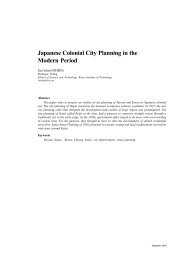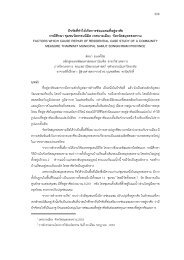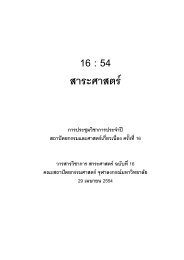Urban Dynamism, a Contrasting Experience: - Faculty of Architecture
Urban Dynamism, a Contrasting Experience: - Faculty of Architecture
Urban Dynamism, a Contrasting Experience: - Faculty of Architecture
Create successful ePaper yourself
Turn your PDF publications into a flip-book with our unique Google optimized e-Paper software.
<strong>Urban</strong> <strong>Dynamism</strong>, a <strong>Contrasting</strong> <strong>Experience</strong>:<br />
Street Life in Unplanned Bangkok and Planned Melbourne<br />
<strong>Urban</strong> <strong>Dynamism</strong>,<br />
a <strong>Contrasting</strong> <strong>Experience</strong>:<br />
Street Life in Unplanned Bangkok and<br />
Planned Melbourne<br />
Sidh Sintusingha<br />
<br />
Kasama Polakit<br />
<br />
<br />
Richard Bruch<br />
<br />
ABSTRACT<br />
T<br />
<br />
<br />
<br />
<br />
<br />
1. INTRODUCTION<br />
As major urban public spaces, streets play a<br />
<br />
political, economic, social and cultural conditions.<br />
<br />
<br />
<br />
<br />
<br />
<br />
<br />
<br />
<br />
<br />
<br />
<br />
<br />
<br />
state<br />
.<br />
Nakhara 93
Sidh Sintusingha / Kasama Polakit / Richard Bruch<br />
Nakhara 94<br />
<br />
<br />
<br />
<br />
<br />
<br />
<br />
<br />
<br />
<br />
<br />
<br />
<br />
<br />
<br />
<br />
<br />
<br />
<br />
<br />
<br />
<br />
<br />
<br />
<br />
<br />
<br />
<br />
2. URBAN DYNAMISM THROUGH<br />
EVERYDAY STREET LIFE<br />
<br />
<br />
<br />
<br />
<br />
<br />
<br />
<br />
<br />
<br />
<br />
<br />
<br />
<br />
<br />
<br />
<br />
<br />
<br />
<br />
<br />
control, simplicity, singularity, neatness and order.
<strong>Urban</strong> <strong>Dynamism</strong>, a <strong>Contrasting</strong> <strong>Experience</strong>:<br />
Street Life in Unplanned Bangkok and Planned Melbourne<br />
<br />
<br />
<br />
<br />
<br />
<br />
<br />
<br />
<br />
buildings can be seen as closed systems. We<br />
<br />
<br />
<br />
<br />
<br />
<br />
<br />
<br />
<br />
<br />
<br />
<br />
<br />
<br />
<br />
<br />
<br />
<br />
<br />
<br />
encourages many social encounters, and stimulates<br />
<br />
<br />
<br />
<br />
<br />
<br />
<br />
<br />
<br />
<br />
<br />
<br />
<br />
<br />
<br />
<br />
<br />
<br />
<br />
<br />
<br />
<br />
<br />
<br />
<br />
<br />
<br />
<br />
<br />
<br />
<br />
<br />
<br />
<br />
<br />
<br />
<br />
<br />
<br />
<br />
<br />
<br />
<br />
<br />
<br />
<br />
<br />
openings relate to open space and create two<br />
<br />
<br />
<br />
<br />
<br />
<br />
<br />
<br />
<br />
<br />
<br />
<br />
<br />
<br />
<br />
<br />
<br />
<br />
<br />
<br />
<br />
<br />
<br />
<br />
<br />
<br />
<br />
outdoor areas across time and space.<br />
Nakhara 95
Sidh Sintusingha / Kasama Polakit / Richard Bruch<br />
<br />
<br />
<br />
<br />
<br />
<br />
<br />
<br />
<br />
<br />
<br />
<br />
<br />
<br />
<br />
<br />
<br />
<br />
<br />
<br />
<br />
<br />
<br />
<br />
<br />
<br />
<br />
<br />
<br />
<br />
and unwritten rules.<br />
<br />
<br />
<br />
<br />
<br />
<br />
<br />
<br />
<br />
<br />
<br />
<br />
<br />
<br />
<br />
<br />
<br />
<br />
<br />
<br />
<br />
portray urban street scenes and narrate stories<br />
<br />
<br />
<br />
<br />
<br />
<br />
<br />
<br />
Nakhara 96
<strong>Urban</strong> <strong>Dynamism</strong>, a <strong>Contrasting</strong> <strong>Experience</strong>:<br />
Street Life in Unplanned Bangkok and Planned Melbourne<br />
3. BANGKOK<br />
Figure 1:<br />
Street life in the old commercial district <strong>of</strong> Sampeng, Bangkok’s Chinatown is possibly an early area where the waterbased<br />
culture metamorphose on land. We hypothesize that Bangkok’s contemporary street life has formal origins/roots<br />
in both its khlongs and the Chinese migrants commercial urban practices (Sintusingha 22/12/08).<br />
<br />
<br />
<br />
<br />
<br />
<br />
<br />
<br />
<br />
<br />
<br />
<br />
<br />
<br />
<br />
<br />
<br />
<br />
<br />
<br />
<br />
<br />
<br />
and contradictory layering concepts in urban<br />
<br />
<br />
<br />
<br />
<br />
<br />
<br />
<br />
<br />
<br />
<br />
<br />
<br />
<br />
<br />
<br />
<br />
<br />
to <br />
<br />
<br />
<br />
<br />
<br />
<br />
<br />
<br />
Nakhara 97
Sidh Sintusingha / Kasama Polakit / Richard Bruch<br />
<br />
<br />
<br />
<br />
<br />
<br />
<br />
<br />
<br />
<br />
<br />
<br />
<br />
<br />
<br />
<br />
<br />
<br />
<br />
<br />
<br />
<br />
<br />
<br />
<br />
<br />
<br />
<br />
<br />
<br />
<br />
to impose control 3 <br />
<br />
<br />
<br />
<br />
<br />
<br />
<br />
<br />
<br />
<br />
<br />
<br />
<br />
and department stores, supermarkets, transnational<br />
and loc<br />
Nakhara 98<br />
Figure 2:<br />
Street life in the old commercial district <strong>of</strong> Pahurat (Bangkok’s ‘Indian Town’) adjacent to Sampeng witnesses the ‘place<br />
<br />
3
<strong>Urban</strong> <strong>Dynamism</strong>, a <strong>Contrasting</strong> <strong>Experience</strong>:<br />
Street Life in Unplanned Bangkok and Planned Melbourne<br />
<br />
<br />
<br />
<br />
<br />
<br />
<br />
<br />
<br />
<br />
<br />
<br />
<br />
<br />
<br />
<br />
<br />
<br />
<br />
<br />
<br />
<br />
<br />
F<br />
<br />
<br />
<br />
<br />
<br />
<br />
<br />
<br />
<br />
<br />
<br />
<br />
sois),<br />
<br />
takraw<br />
<br />
<br />
<br />
<br />
<br />
<br />
4. MELBOURNE<br />
<br />
<br />
<br />
<br />
<br />
<br />
<br />
<br />
<br />
<br />
<br />
Figure 3:<br />
<br />
<br />
informal. Note the congregation <strong>of</strong> youths to the left not participating in the introduced café/restaurant culture (Sintusingha<br />
14/09/09).<br />
Nakhara 99
Sidh Sintusingha / Kasama Polakit / Richard Bruch<br />
Nakhara 100<br />
<br />
<br />
<br />
<br />
<br />
<br />
<br />
<br />
<br />
<br />
<br />
<br />
<br />
<br />
<br />
<br />
<br />
<br />
<br />
<br />
<br />
<br />
<br />
<br />
<br />
<br />
geared towards pedestrians, cyclists and public<br />
<br />
<br />
<br />
<br />
<br />
<br />
<br />
<br />
<br />
<br />
<br />
<br />
<br />
<br />
<br />
<br />
<br />
<br />
<br />
<br />
<br />
<br />
<br />
<br />
<br />
<br />
<br />
<br />
<br />
<br />
<br />
<br />
<br />
<br />
<br />
<br />
<br />
building stock towards residential accommodation.<br />
<br />
<br />
<br />
<br />
<br />
<br />
“designed to reintroduce a residential population<br />
<br />
<br />
<br />
<br />
<br />
<br />
<br />
<br />
<br />
<br />
<br />
international students attending city campuses was
<strong>Urban</strong> <strong>Dynamism</strong>, a <strong>Contrasting</strong> <strong>Experience</strong>:<br />
Street Life in Unplanned Bangkok and Planned Melbourne<br />
<br />
<br />
<br />
<br />
<br />
<br />
<br />
<br />
<br />
<br />
<br />
<br />
<br />
<br />
<br />
<br />
<br />
<br />
<br />
<br />
<br />
<br />
<br />
emerge<br />
<br />
<br />
<br />
<br />
<br />
<br />
<br />
<br />
<br />
<br />
<br />
<br />
<br />
<br />
<br />
<br />
<br />
<br />
<br />
Figure 4:<br />
Through the 2008 action research project “Couch Sit”; <strong>Urban</strong> Village Melbourne Inc questioned whether formal physical<br />
appropriation <strong>of</strong> public space was the only mechanism by which private interests excluded public uses <strong>of</strong> city space.<br />
Seated on a red household couch from 11am on a weekday, the researchers occupied a section <strong>of</strong> a sidewalk on Collins<br />
Street near to the intersection with Elizabeth Street. While the neighboring bank had no physical or legal claims to the<br />
sidewalk, after two hours the bank manager confronted the research team (pictured), and after four hours the team was<br />
asked to move on by the Victoria Police at the request <strong>of</strong> the bank manager. The <strong>Urban</strong> Village Melbourne Inc. research<br />
team argues that this exposes a behavioral mechanism, by which private interests seek to control public uses <strong>of</strong> city<br />
space adjoining their own active frontages.<br />
Nakhara 101
Sidh Sintusingha / Kasama Polakit / Richard Bruch<br />
<br />
<br />
<br />
<br />
<br />
<br />
<br />
<br />
<br />
<br />
<br />
increas <br />
<br />
<br />
<br />
<br />
<br />
<br />
<br />
<br />
<br />
<br />
<br />
<br />
<br />
<br />
<br />
<br />
<br />
<br />
<br />
<br />
<br />
<br />
<br />
<br />
<br />
<br />
<br />
<br />
<br />
<br />
<br />
<br />
<br />
<br />
<br />
5. CONCLUSIONS<br />
<br />
<br />
<br />
<br />
<br />
<br />
<br />
<br />
<br />
<br />
<br />
<br />
Table 1:<br />
Ingredients <strong>of</strong> street life Bangkok Melbourne CBD<br />
Nakhara 102<br />
1.Density <br />
population)<br />
<br />
<br />
<br />
<br />
<br />
<br />
<br />
in population in inner Bangkok<br />
<br />
<br />
<br />
registered residences and actual<br />
<br />
<br />
<br />
<br />
<br />
<br />
<br />
<br />
<br />
<br />
trend is projected increases
<strong>Urban</strong> <strong>Dynamism</strong>, a <strong>Contrasting</strong> <strong>Experience</strong>:<br />
Street Life in Unplanned Bangkok and Planned Melbourne<br />
Table 1:<br />
2. <strong>Urban</strong> morphology<br />
<br />
<br />
<br />
<br />
ability)<br />
<br />
<br />
<br />
<br />
<br />
<br />
<br />
<br />
<br />
<br />
enclosed spatial system<br />
<br />
<br />
<br />
soi) and<br />
trok<br />
<br />
<br />
streets.<br />
<br />
<br />
<br />
<br />
<br />
<br />
<br />
<br />
malls<br />
<br />
spatial system<br />
<br />
<br />
<br />
<br />
<br />
<br />
<br />
<br />
<br />
<br />
<br />
<br />
<br />
3. Functionality, uses,<br />
activities<br />
<br />
<br />
<br />
<br />
<br />
<br />
<br />
<br />
<br />
<br />
<br />
<br />
<br />
<br />
<br />
<br />
<br />
<br />
<br />
<br />
day<br />
<br />
<br />
<br />
Formal commercial and cultural<br />
<br />
<br />
commercial and cultural<br />
<br />
uses<br />
<br />
4. Operation (spatial and<br />
temporal dimension)<br />
<br />
<br />
unwritten rules<br />
<br />
<br />
<br />
<br />
<br />
<br />
unwritten rules and tacit<br />
<br />
<br />
<br />
<br />
<br />
<br />
based on rules and<br />
regulations<br />
<br />
<br />
Nakhara 103
Sidh Sintusingha / Kasama Polakit / Richard Bruch<br />
Nakhara 104<br />
<br />
<br />
<br />
<br />
<br />
<br />
<br />
<br />
<br />
<br />
<br />
<br />
<br />
<br />
<br />
<br />
<br />
<br />
<br />
<br />
<br />
Bangkok’s conurbation.<br />
<br />
<br />
<br />
<br />
<br />
<br />
<br />
<br />
<br />
<br />
<br />
<br />
<br />
<br />
<br />
<br />
<br />
<br />
<br />
<br />
<br />
<br />
<br />
<br />
<br />
<br />
demarcation and separation between pedestrian,
<strong>Urban</strong> <strong>Dynamism</strong>, a <strong>Contrasting</strong> <strong>Experience</strong>:<br />
Street Life in Unplanned Bangkok and Planned Melbourne<br />
REFERENCES<br />
<br />
<br />
<br />
<br />
<br />
<br />
<br />
<br />
<br />
The Timeless Way <strong>of</strong> Building.<br />
<br />
<br />
The City Reader<br />
<br />
Bangkok Post<br />
<br />
<br />
<br />
Responsive Environments <br />
<br />
The City <strong>of</strong> Collective Memory.<br />
<br />
<br />
Environment and<br />
Natural Resources Journal<br />
<br />
<br />
<br />
<br />
<br />
<br />
<br />
<br />
<br />
<br />
<br />
<br />
Framing Places: Mediating power in built<br />
form Routledge.<br />
<br />
<br />
<br />
<br />
<br />
<br />
<br />
<br />
<br />
<br />
<br />
<br />
Images <strong>of</strong> the Street: planning,<br />
identity, and control in public space. <br />
<br />
<br />
<br />
<br />
<br />
<br />
<br />
The Constitution <strong>of</strong> Society: Outline <strong>of</strong><br />
the Theory <strong>of</strong> Structuration. <br />
Space is the Machine. <br />
<br />
<br />
<br />
Space Syntax<br />
UCL in <br />
<br />
Space Syntax UCL in<br />
<br />
<br />
<br />
<br />
<strong>Architecture</strong> & Behavior, 3 (<br />
<br />
<br />
State <strong>of</strong> Australian Cities 05:<br />
Conference proceedings <br />
<br />
<br />
<br />
<br />
Domestic architecture and the use <strong>of</strong><br />
space: An interdisciplinary cross-cultural study<br />
ss.<br />
The social logic <strong>of</strong> space.<br />
<br />
<br />
<br />
<br />
The Death and Life <strong>of</strong> Great American<br />
Cities. Random House.<br />
What time is this place?<br />
s.<br />
Nakhara 105
Sidh Sintusingha / Kasama Polakit / Richard Bruch<br />
Good city form. <br />
Design <strong>of</strong> <strong>Urban</strong> Space. West<br />
<br />
Investigations in Collective Form <br />
<br />
<br />
<br />
<br />
<br />
<br />
The City Reader<br />
<br />
<br />
<br />
<strong>Urban</strong> Policy and<br />
Research<br />
<br />
<strong>Urban</strong><br />
History Review<br />
<br />
<br />
Bangkok. Modernity, Tradition, Culture, Water:<br />
Proceedings <strong>of</strong> an International Symposium<br />
<br />
<br />
<br />
<br />
Eco-<strong>Urban</strong>ity: Towards Well-Mannered<br />
Built Environments<br />
Finding Lost Space: Theories <strong>of</strong> urban<br />
design. <br />
<br />
<br />
<br />
<br />
<br />
The City Reader <br />
<br />
<br />
<br />
<br />
<br />
<br />
<br />
Local Sustainable <strong>Urban</strong><br />
Development in a Globalized World <br />
<br />
The Meaning <strong>of</strong> the Built Environment:<br />
A nonverbal communication approach. <br />
<br />
<br />
Domestic architecture and the use <strong>of</strong> space:<br />
An interdisciplinary cross-cultural study <br />
<br />
The <strong>Architecture</strong> <strong>of</strong> the City. <br />
<br />
A Georgraphy <strong>of</strong> the Lifeworld:<br />
Movement, Rest and Encounter.<br />
Nakhara 106<br />
<br />
The Human <strong>Experience</strong> <strong>of</strong> Space<br />
and Place <br />
<br />
The Consciences <strong>of</strong> the Eye: The<br />
design <strong>of</strong> social life <strong>of</strong> cities


